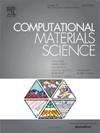Insight into phase stability and mechanical behavior of HfB2 and HfB12 under high pressures and high temperatures: A first−principles investigation
IF 3.1
3区 材料科学
Q2 MATERIALS SCIENCE, MULTIDISCIPLINARY
引用次数: 0
Abstract
Previous attempts to synthesize pure crystalline hafnium dodecaboride (HfB12) have been unsuccessful, raising doubts about its existence as one of the thermodynamically stable phases in the binary HfB system. In this work, we employ first-principles calculations based on density functional theory and quasi-harmonic approximation to evaluate the phase stability of HfB12 with respect to its competing phases, in particular HfB2, across a range of pressures of 020 GPa and of temperatures of 01200 K to determine the conditions under which HfB12 is stable from the thermodynamic aspect. Our results suggest that HfB12 could be thermodynamically stabilized only at temperatures higher than 1100 K and within a narrow pressure range that broadens with increasing temperature. On the contrary, HfB2 is identified as a thermodynamically stable phase in the HfB system for all considered temperatures and pressures. By investigating the mechanical behaviors and phonon dispersion curves of HfB2 and HfB12, we confirm that the two compounds are mechanically and dynamically stable. Also, we demonstrate that HfB2 exhibits superhard behavior with a Vickers hardness exceeding the superhard threshold of 40 GPa, while the values for Vickers hardness of HfB12 are predicted to fall slightly below the threshold. This comprehensive study of HfB2 and HfB12 sheds light on their phase stability and mechanical behavior, offering a valuable insight into future synthesis of the materials and their potential uses as hard-coating materials for cutting tools.

求助全文
约1分钟内获得全文
求助全文
来源期刊

Computational Materials Science
工程技术-材料科学:综合
CiteScore
6.50
自引率
6.10%
发文量
665
审稿时长
26 days
期刊介绍:
The goal of Computational Materials Science is to report on results that provide new or unique insights into, or significantly expand our understanding of, the properties of materials or phenomena associated with their design, synthesis, processing, characterization, and utilization. To be relevant to the journal, the results should be applied or applicable to specific material systems that are discussed within the submission.
 求助内容:
求助内容: 应助结果提醒方式:
应助结果提醒方式:


